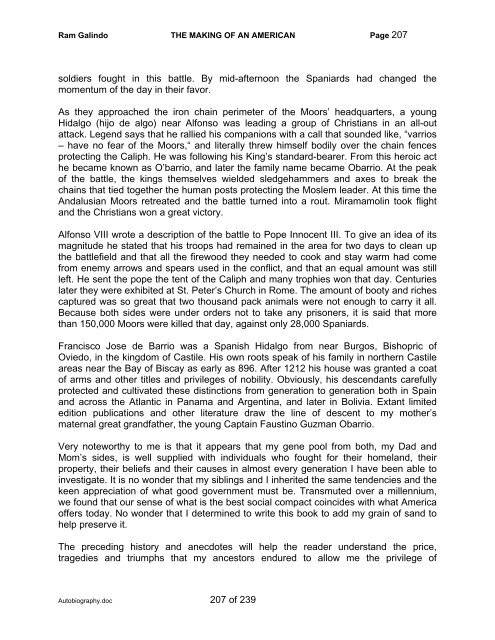Autobiography - The Galindo Group
Autobiography - The Galindo Group
Autobiography - The Galindo Group
Create successful ePaper yourself
Turn your PDF publications into a flip-book with our unique Google optimized e-Paper software.
Ram <strong>Galindo</strong> THE MAKING OF AN AMERICAN Page 207<br />
soldiers fought in this battle. By mid-afternoon the Spaniards had changed the<br />
momentum of the day in their favor.<br />
As they approached the iron chain perimeter of the Moors’ headquarters, a young<br />
Hidalgo (hijo de algo) near Alfonso was leading a group of Christians in an all-out<br />
attack. Legend says that he rallied his companions with a call that sounded like, “varrios<br />
– have no fear of the Moors,“ and literally threw himself bodily over the chain fences<br />
protecting the Caliph. He was following his King’s standard-bearer. From this heroic act<br />
he became known as O’barrio, and later the family name became Obarrio. At the peak<br />
of the battle, the kings themselves wielded sledgehammers and axes to break the<br />
chains that tied together the human posts protecting the Moslem leader. At this time the<br />
Andalusian Moors retreated and the battle turned into a rout. Miramamolin took flight<br />
and the Christians won a great victory.<br />
Alfonso VIII wrote a description of the battle to Pope Innocent III. To give an idea of its<br />
magnitude he stated that his troops had remained in the area for two days to clean up<br />
the battlefield and that all the firewood they needed to cook and stay warm had come<br />
from enemy arrows and spears used in the conflict, and that an equal amount was still<br />
left. He sent the pope the tent of the Caliph and many trophies won that day. Centuries<br />
later they were exhibited at St. Peter’s Church in Rome. <strong>The</strong> amount of booty and riches<br />
captured was so great that two thousand pack animals were not enough to carry it all.<br />
Because both sides were under orders not to take any prisoners, it is said that more<br />
than 150,000 Moors were killed that day, against only 28,000 Spaniards.<br />
Francisco Jose de Barrio was a Spanish Hidalgo from near Burgos, Bishopric of<br />
Oviedo, in the kingdom of Castile. His own roots speak of his family in northern Castile<br />
areas near the Bay of Biscay as early as 896. After 1212 his house was granted a coat<br />
of arms and other titles and privileges of nobility. Obviously, his descendants carefully<br />
protected and cultivated these distinctions from generation to generation both in Spain<br />
and across the Atlantic in Panama and Argentina, and later in Bolivia. Extant limited<br />
edition publications and other literature draw the line of descent to my mother’s<br />
maternal great grandfather, the young Captain Faustino Guzman Obarrio.<br />
Very noteworthy to me is that it appears that my gene pool from both, my Dad and<br />
Mom’s sides, is well supplied with individuals who fought for their homeland, their<br />
property, their beliefs and their causes in almost every generation I have been able to<br />
investigate. It is no wonder that my siblings and I inherited the same tendencies and the<br />
keen appreciation of what good government must be. Transmuted over a millennium,<br />
we found that our sense of what is the best social compact coincides with what America<br />
offers today. No wonder that I determined to write this book to add my grain of sand to<br />
help preserve it.<br />
<strong>The</strong> preceding history and anecdotes will help the reader understand the price,<br />
tragedies and triumphs that my ancestors endured to allow me the privilege of<br />
<strong>Autobiography</strong>.doc 207 of 239


